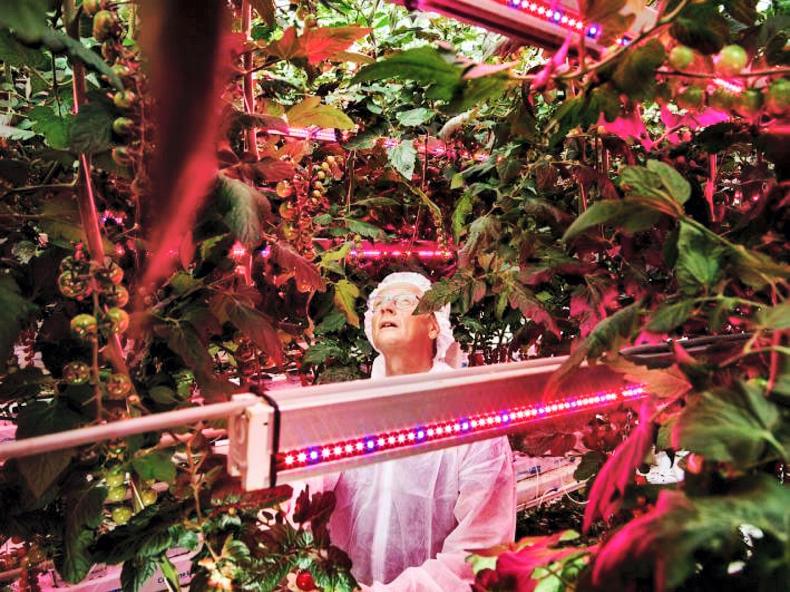There is a huge focus on the development of drone technology to monitor crops. One of many challenges with drones which needs to be addressed is short battery life.
However, researchers at the University of Washington have developed a novel way of monitoring crops, using insects. The researchers have developed sensor backpacks that are small and light enough (about 0.0035 ounces) to sit on a bumblebee and can collect data for seven hours at a time over relatively long distances. The bees then fly into the hives where they wirelessly recharge and transmit data.

The sensor weights just sensor 0.0035 ounces.
The prototype backpacks are only capable of storing about 30kb of data. This limits them to collecting basic information such as humidity, light and temperature. The researchers hope to develop more elaborate data gathering technology (including live data). They believe that eventually we’ll see bees continuously checking on crops and transmitting the data back to farmers.
The robotic revolution on tillage farms seems closer than ever. As reported in the Irish Farmers Journal previously, the UK-based Small Robot Company is aiming to re-imagine farming through the development of farming robots. The farmbots come in three models, Tim, Dick and Harry, and work to first identify what crops in the field require attention before targeting those plants with fertiliser, herbicides, fungicides, etc.

Tom is the scouting robot.
Ben Scott Robinson, co-founder of the company, says these robots will be capable of going 24-7 and he aims to launch the robot leasing service by 2022. He envisages charging a fixed fee of around €670/ha to hire the robots for the year.
The John Lewis Partnership, parent company of the Waitrose supermarket chain, recently entered into an agreement with the Small Robot Company to begin a three-year trial to test out a trio of miniature farmbots on the Lewis Leckford Estate, England, which grows produce for Waitrose.
Technology first developed by Nasa to grow plants extra-terrestrially is now being used by scientists to fast track crop breeding.
Scientists from a number of UK universities have adapted the technology to work in glasshouses to facilitate “speed breeding”.

A scientist checks on tomatoes grown with different exposures to LED lights at a research center in the Netherlands.
The process of speed breeding involves the use of enhanced LED lighting and day-long regimes of up to 22 hours to optimise photosynthesis and promote rapid growth of crops. The process essentially speeds up the breeding cycle of plants.
By doing this, scientists and plant breeders can make accelerated genetic improvements through breeding, such as yield improvements, disease resistance and tolerance to climate change in a variety of crops, such as wheat, barley, rapeseed and peas.
Read more
Christmas closed the door on another year
Irish main crop potato harvest lowest since 2012
There is a huge focus on the development of drone technology to monitor crops. One of many challenges with drones which needs to be addressed is short battery life.
However, researchers at the University of Washington have developed a novel way of monitoring crops, using insects. The researchers have developed sensor backpacks that are small and light enough (about 0.0035 ounces) to sit on a bumblebee and can collect data for seven hours at a time over relatively long distances. The bees then fly into the hives where they wirelessly recharge and transmit data.

The sensor weights just sensor 0.0035 ounces.
The prototype backpacks are only capable of storing about 30kb of data. This limits them to collecting basic information such as humidity, light and temperature. The researchers hope to develop more elaborate data gathering technology (including live data). They believe that eventually we’ll see bees continuously checking on crops and transmitting the data back to farmers.
The robotic revolution on tillage farms seems closer than ever. As reported in the Irish Farmers Journal previously, the UK-based Small Robot Company is aiming to re-imagine farming through the development of farming robots. The farmbots come in three models, Tim, Dick and Harry, and work to first identify what crops in the field require attention before targeting those plants with fertiliser, herbicides, fungicides, etc.

Tom is the scouting robot.
Ben Scott Robinson, co-founder of the company, says these robots will be capable of going 24-7 and he aims to launch the robot leasing service by 2022. He envisages charging a fixed fee of around €670/ha to hire the robots for the year.
The John Lewis Partnership, parent company of the Waitrose supermarket chain, recently entered into an agreement with the Small Robot Company to begin a three-year trial to test out a trio of miniature farmbots on the Lewis Leckford Estate, England, which grows produce for Waitrose.
Technology first developed by Nasa to grow plants extra-terrestrially is now being used by scientists to fast track crop breeding.
Scientists from a number of UK universities have adapted the technology to work in glasshouses to facilitate “speed breeding”.

A scientist checks on tomatoes grown with different exposures to LED lights at a research center in the Netherlands.
The process of speed breeding involves the use of enhanced LED lighting and day-long regimes of up to 22 hours to optimise photosynthesis and promote rapid growth of crops. The process essentially speeds up the breeding cycle of plants.
By doing this, scientists and plant breeders can make accelerated genetic improvements through breeding, such as yield improvements, disease resistance and tolerance to climate change in a variety of crops, such as wheat, barley, rapeseed and peas.
Read more
Christmas closed the door on another year
Irish main crop potato harvest lowest since 2012









 This is a subscriber-only article
This is a subscriber-only article









SHARING OPTIONS: